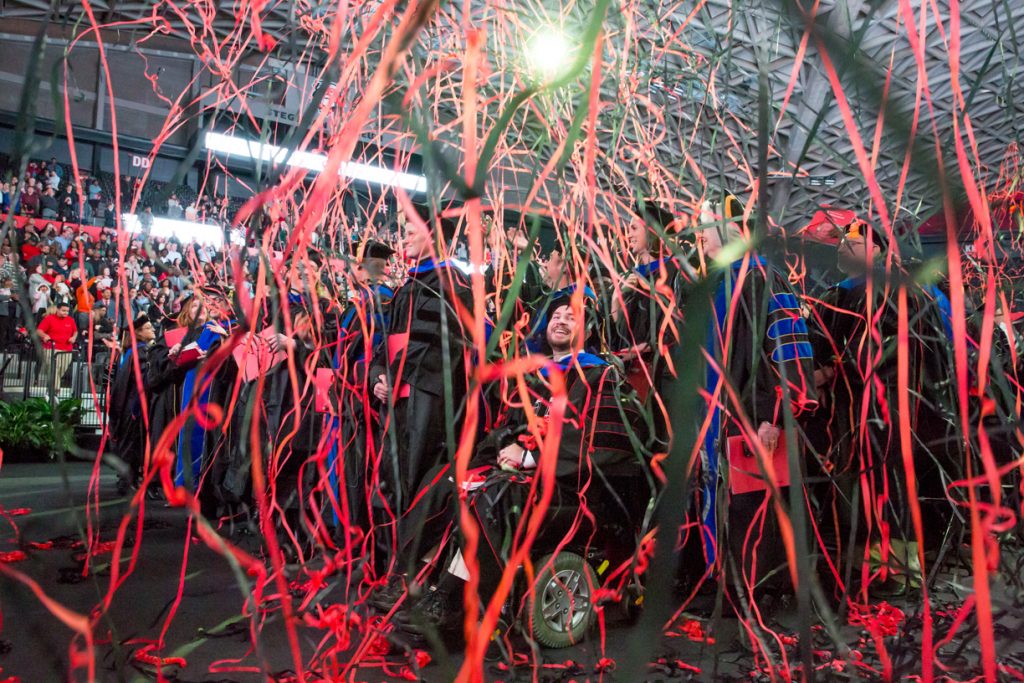Matthew Houston’s Probability of Success is Great
Matthew Houston earned a doctorate in mathematical biology, parlaying his interests and skills into muscular dystrophy research.
The UGA Graduate School graduation ceremonies were set the following day and new Ph.D. Matthew Houston was ready to be hooded.
His doctoral studies were complicated beyond the usual stresses. He worked full time as well, while coping with the progressive disease muscular dystrophy.
Houston had done it.
“Something we might want to tell the world,” noted his UGA mentor and doctoral advisor, Juan B. Gutierrez, when Houston achieved his dream on December 14, 2018.
Gutierrez had paired his mentee with an undergraduate student who was also dealing with medical challenges in order for them to begin a collaborative study, reviewing mathematical models about muscular dystrophy.
Rather than shelving his doctoral plans, Houston had turned his increasing physical difficulties into a point of motivation; it became a reason to drive and inform his research.
Uncomplainingly, too, he held tight to his intentions to keep his resolve, no matter how improbable his plan might have seemed.
Crossing the finish line last December was proof of the power of the human spirit over all obstacles.
By: Cynthia Adams | Photos By: Nancy Evelyn
It was a chilly December afternoon in Athens and Matthew and Melissa Houston were about to do something they had long anticipated.
And it would begin the next day, by ignoring the alarm clock, waiving their usual 2:40 wake up time. Matthew wouldn’t be up and out the door at 5:00 a.m., for his former commute to his teaching job at Middle Georgia State University in Cochran, Ga.
It would be a leisurely start to the day of the 2018 Graduate School graduation ceremonies at Stegeman Coliseum.
Afterward, Melissa would join Matthew’s parents to cheer as Matthew was hooded.
The proud family smiled until their faces hurt.
December 14 marked a dream realized, one to be shared with their extended family, many of them fellow UGA alums as well.
To make things even more celebratory, Matthew’s graduation weekend fell on the couple’s sixth wedding anniversary. The Houstons planned to extend the celebration in Atlanta, joining a large family group at their favorite eatery.
Melissa joined Matthew in a downtown hotel lobby as he described his journey to a doctorate. As an alumnus herself with two UGA degrees, she listened attentively, as if she didn’t know his story insideout. She wore an expression of pride for her spouse: Matthew had done it.
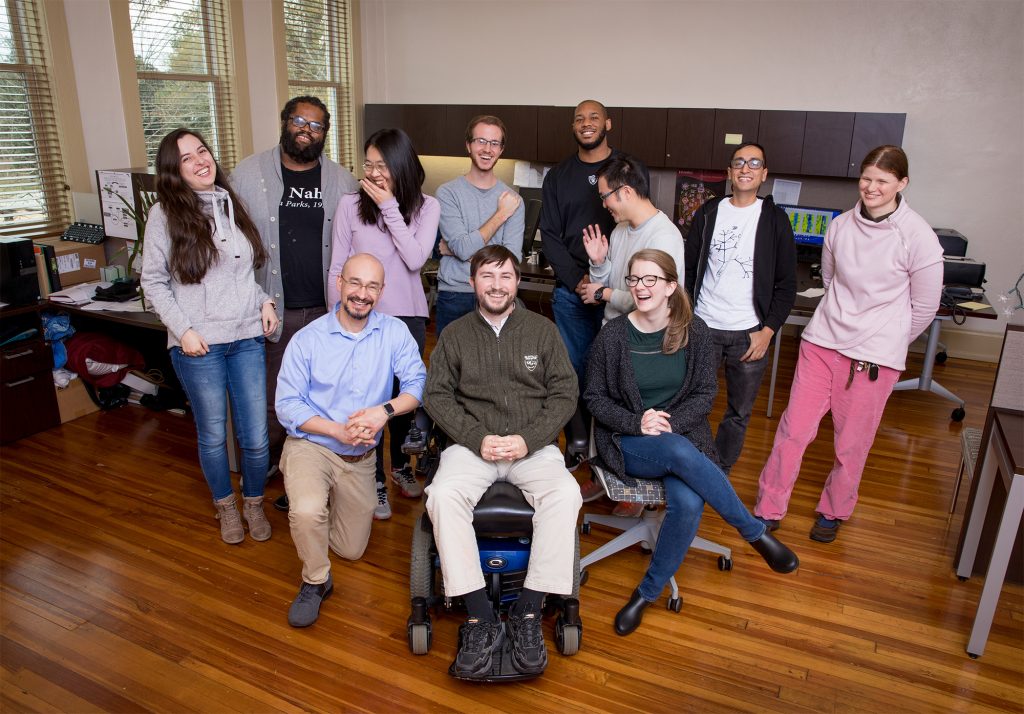
All along, Matthew had shown both a natural aptitude for mathematics and research. His dissertation employed experience and abilities: what he knew about a debilitating disease and his own mathematical skills and ability to create a mathematical model for muscle repair in muscular dystrophy. (Back row:) Karen Gonzalez, Zerotti Woods, Jinsil Lee, Zachary Petty, Jordan Clark, Kun-Lin Ho, Diego Moncada, Elizabeth Trippe (Front row:) Juan B Gutierrez, Matthew Houston, and Jessica Brady.
His dissertation topic was a mathematical model for immunological interactions in muscular dystrophy pathogenesis. His study and life had intersected, were synchronous.
“It’s the culmination of Matt’s incredible determination. His strength despite all. His obstacles that seemed insurmountable,” Melissa said proudly.
Matthew added quietly, smilingly, “Thank God.”
Melissa continued. “And, he had the integrity to see it to this place.” By this place, she meant the all-important finish line—the top academic achievement—earning a Ph.D.
Matthew’s mentor and former doctoral advisor, Juan B. Gutierrez is in the UGA Department of Mathematics and the Institute of Bioinformatics. Gutierrez was among other important influences that Matthew mentions.
“I had several incredible professors at UGA that helped me find my voice,” he says. “Dr. Edward Azoff, Dr. Caner Kazanci, Dr. Ming-Jun Lai, and my advisor.”
After Matthew defended his dissertation last summer, Gutierrez emailed Suzanne Barbour, the Graduate School dean, to call attention to his mentee’s achievements.
“Matthew T. Houston [who successfully defended in June 2018] has muscular dystrophy,” he wrote.
“When he started classes he was on crutches, now he drives (and sometimes speeds in) a wheelchair. His dissertation was about mathematical models of muscular dystrophy. He did this while being a full-time instructor at Middle Georgia State University which is near Macon. He would commute to Athens (two hour drive each way) just to attend classes and lab meetings.”
The professor added: “His success is inspirational…
I believe this is something we might want to tell the world.”
Gutierrez had been instrumental in Matthew’s ultimate focus, as Matthew explains. “The initial research into modeling muscular dystrophy led to my dissertation.”
All along, Matthew had shown a natural aptitude for both mathematics and research. His dissertation employed experience and abilities: what he knew about a debilitating disease and his own mathematical skills and ability to create a mathematical model for muscle repair in muscular dystrophy.
From his youth, Matthew had believed mathematics held symbolic keys to universal problems. That symbolism, he explained, helped us “understand key facets into the way our biology works, and it can help us understand what can be needed when there is a problem that needs to be solved.” This became the foundation of his dissertation.
In addition, he demonstrated a mental resilience, an emotional toughness; especially, a willingness to persevere. For the last four years, Matthew rose hours before dawn in order to meet both his doctoral demands at UGA as well as the demands of full employment as an instructor two hours away.
“I lived in Athens and traveled to Cochran,” he explains simply.
The couple, who married in 2012, made one adjustment, shifting their residence from Perry, Ga. “We moved to Athens in 2014 when I started (doctoral studies) to make study sessions easier.”
Melissa adds, “The last year, we did it without a second car.”
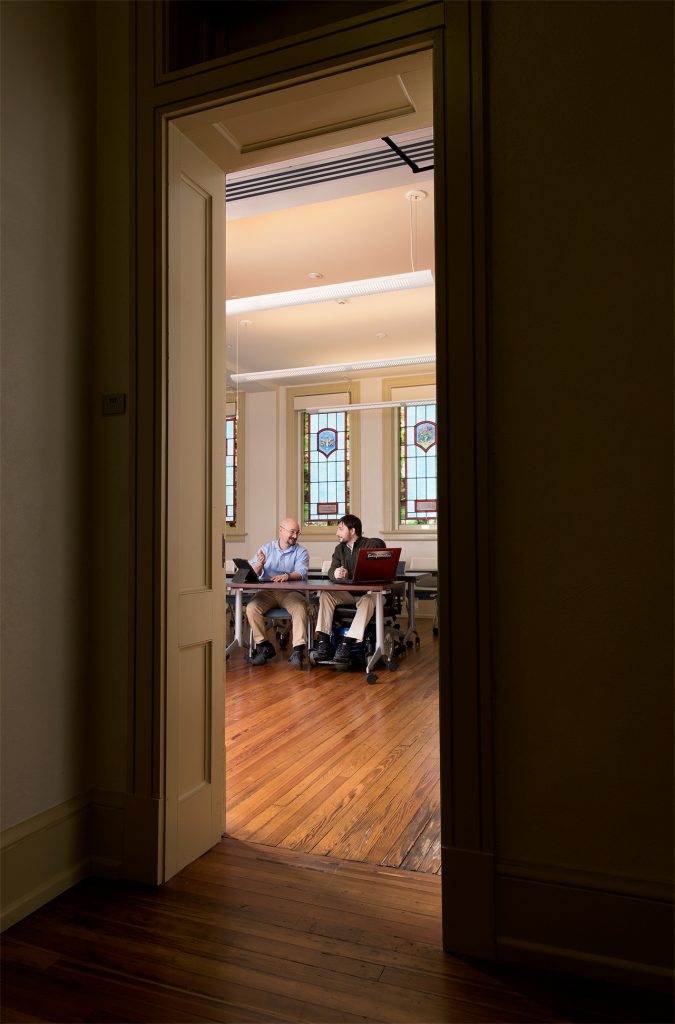
“His success is inspirational…I believe this is something we might want to tell the world.”
—Mentor and former doctoral advisor, Juan B. Gutierrez, UGA Department of Mathematics and the Institute of Bioinformatics
“I’m a Geek and a Nerd Who Actually Enjoys This Stuff!”
In January of 2010, Matthew began teaching in the Department of Mathematics at Middle Georgia State University in Cochran, a small town near Macon. During the first two years teaching there, he taught a minimum of 18 credit hours.
In 2013, he was awarded Professor of the Year at Middle Georgia. The honor was voted upon and decided by students of the Student Government Association. It became one of his most important achievements.
In January the next year, Matthew made contact with the UGA department of Mathematics and attended the department’s Visitation Day. Six months later, he applied to the doctoral program. Matthew also decided to take advantage of the Tuition Assistance Program, TAP. TAP would allow him to essentially work off his tuition debt while working as an employee of the University system.
Matthew was still able to walk without a cane when he began studies in August 2014, with most of his classes held in Boyd Graduate Studies.
He still commuted independently. Twice weekly, he drove from Athens to Middle Georgia State University in Cochran, teaching a full load of classes with the connection and brio that had won him the student award.
He also focused on graduate classes, concentrated in mathematics, chemistry and biology.
“Teaching and learning became a dance of sorts,” says Melissa, “with each class as professor and each class as student offering more than compelling motivation for him to continue in his Ph.D. program.” The fusion of the two, she says, gave him strength.
Matthew’s hope was he would eventually do scientific research that might help other muscular dystrophy patients by concentrating in bioinformatics.
In time, however, he began requiring the use of a cane.
How had he done it? And also, why had he done it?
Formative Years
Matthew grew up in LaGrange, Ga., where he attended public school. His parents teased out academic challenges and promoted excellence—his siblings were all good students as he is quick to mention.
Since boyhood, Matthew kept a yellow note pad, jotting down mathematical concepts.
By eight grade he discovered a love of math, joining the math team and participating in state competitions. Later, in high school algebra classes, he discovered something else: he was far more interested in the why of solving a problem than the how. In his view, math explained why the world worked as it did.
Until age 10, Matthew rode a bike, played sports, rock climbed, hiked, ran, and soon entered Scouting. By age 11, he began complaining of muscle tiredness. Still, nothing was “glaringly obvious” he explains. Nothing more serious seemed amiss.
Matthew did, however, have noticeably large calf muscles—yet this was attributed to his soccer playing. He had another unique trait: Matthew walked and ran on the balls of his feet.
Physicians recommended stretching exercises for his tight Achilles tendons.
By high school, Matthew had slowed noticeably. The same teenager who enjoyed soccer and running gave up team sports altogether.
Matthew joined chorus, choosing something less physical. But even that presented challenges. High school chorus performances required both singing and dancing. Matthew found it very difficult to perform dance lifts with his partner.
As he emailed, “there is the sneaky onset of muscle weakening.”
Something was wrong yet undefinable. As for his mental development, he was speeding forward and gathering strength.
In his sophomore year of high school, Matthew and his family relocated from Georgia to Morristown, Tenn., where Matthew entered Morriston-Hamblen West High. He flung himself into academic challenges. Teachers Jeff Kinsler and Gene Quarles suggested he prove the mathematical theorems he liked working on in his spare time.
His high school teachers helped him realize his mathematical ideas had value and were worth pursuing.
But while Matthew’s mental progress was sure-footed, his physical strength was ebbing.
Matthew joined the Academic Bowl and his new high school’s chorus, and during evenings volunteered to help with stage lighting at Walter State, a nearby college. Climbing ladders to assist during rehearsals and stage set-ups was especially difficult for Matthew, who worried he couldn’t manage to hold onto the ladder.
Despite increasing physical weakness, Matthew kept up with classes and extracurricular activities. His doctors had not determined an underlying cause, even as he completed high school.
The mystery persisted. “Something was wrong, but no one knew what it was yet,” Melissa notes.
There were, however, two clues: Matthew showed continuing weakness and he still walked on the balls of his feet. Otherwise he reported feeling fine, and happy to begin enter college studies in engineering and mathematics.
As Matthew was about to enter Tennessee Technological University a pre-collegiate physical revealed elevated liver enzymes. Matthew was referred to a specialist at the University of Tennessee. More tests and a liver biopsy followed, but, no definitive answers were offered.
Yet again, Matthew was referred to another specialist, this time at Vanderbilt University’s Medical Center. This, too, proved fruitless. The Vanderbilt physician was also was at a loss, and suggested that whatever was happening to Matthew was likely rare.
“A zebra,” the specialist observed, using the familiar medical metaphor for diagnosing an anomaly.
In a “herd of horses” was an undetected “zebra” hiding? Matthew’s issues would be determined by noting each and every symptom.
Meanwhile, Matthew was a typical teenager anticipating collegiate life at Tennessee Tech. He was assigned a room on the fourth floor in a dormitory without an elevator. Matthew began having frequent falls navigating the stairs. His knee would unpredictably buckle while he walked across campus, also causing falls.
At the end of his freshman year, Matthew finally told his family about his stability problems. His mother reached out to their family physician.
When Matthew visited his general practitioner, he saw how his advancing weakness surprised her. She asked Matthew to lie down on the floor and then to stand. He succeeded in this only by first rolling over, using his hands and arms to stand by degrees. The leveraging effort is known as the Gower Maneuver, a classic indication of muscular dystrophy.
The doctor next asked Matthew to sit down and then to stand without using his hands.
He could not.
His physician “was almost tearful” he recalls. The two exercises revealed severe weakness in his proximal muscles, weakness that was atypical for a 19-year-old former athlete.
She recognized that Matthew’s liver enzymes were elevated due to the breakdown of his own muscle tissue, not due to liver disease as once suspected.
All the symptoms pointed to a late onset, slow progressing form of muscular dystrophy. Muscular dystrophy was the so called “zebra” in the herd.
There were more questions than answers offered to a shocked Matthew. Muscular dystrophy progressed at an unknown rate. Nothing was available insofar as treatment, and there was no known cure.
It would be years before a genetic test would subsequently determine the type: Matthew had Limb-Girdle Muscular Dystrophy 2i (LGMD2i).
Muscular Dystrophy
The Mayo Clinic’s website defines muscular dystrophy as a group of progressive diseases causing muscle loss and weakness.
In the case of Matthew Houston, indications of late onset muscular dystrophy went unrecognized until he was 19 years of age.
“Signs that I had MD can be seen as far back as 8th grade (1998-1999). However, my pediatrician did not recognize the clues (late onset MD was not well understood at the time),” says Houston, who is now 33.
“I was not diagnosed until the summer of 2004. Our family doctor connected my high creatinine kinase count/liver enzymes and my constantly falling to recognize MD. A neurologist verified this diagnosis a few months later. I was finally genetically diagnosed with LGMD2i in 2015 when the Jane Foundation offered free genetic testing to differentiate MD patients. By that point though, my symptoms were fairly obvious.”
Houston says, “One interesting fact about LGMD2i is only about one person in 200,000 have it, and MD as a group only affects around 68 people per 100,000.”
Navigating a New Normal
Characteristically positive, Matthew had moved forward with his life plans. Even though he had at last an answer for his medical mystery, the answer was not expected. He struggled “with a new normal, knowing life was now on a different trajectory.”
He finished his undergraduate degree at Tennessee Tech in May 2007, and entered their master’s program in Mathematics.
Between semesters, Matthew interned with ConAgra in California’s Central Valley. While there, he collected and tested samples from farmers’ ponds, working on ranch lands and often around livestock. The reality of muscular dystrophy meant he had realistic concerns. If he toppled into a pond while taking test samples, how would he get out?
Still, Houston persevered, and did not allow those worries to prevent him from carrying forward.
In 2009, he finished his master’s in Mathematics, writing a thesis on “Ahmes Expansions over Certain Euclidean Domains.” But his education wasn’t finished—he knew he would continue.
“I always wanted a Ph.D.,” he says, and had known for a while.
“I watched them hood the engineering Ph.D.s at Tennessee Tech. I wanted to do it, but also wanted to work first.”
The next year he returned to Georgia, accepting a teaching position at Middle Georgia State University in Cochran in 2010.
“During my visit for the interview, I felt that I could make a difference here in the lives of students that I felt needed it, and that MGA was a good institution.”
While there he first heard about a program offering an important educational benefit— but only if he could maintain both work and study obligations.
“I started at Middle and learned about the Tuition Assistance Program, available to employees of the University system,” Matthew says.
He had a full teaching load, but he decided to take advantage of TAP and begin doctoral studies anyway. If he could pull it off, he would graduate debt-free.
TAP also made Matthew a rarity of sorts back in Athens.
“No one at UGA in the Math department has done this,” he says. “The Math department didn’t even know what TAP was.”
A new schedule began: Two days a week Matthew was in Cochran teaching; the rest of the time, he was attending classes in Athens. He traveled a two-and-a half hour route, through small towns and rural farming roads. He commuted with tractors and lumbering combines along rural roads that laced acres of farmlands. “America’s breadbasket,” he says seriously.
He was also punctual to a fault. “One semester, I left at 4:00 a.m. in order to make an 8:00 o’clock class,” says Matthew. “And I would get home by 10 p.m.”
At about the same time that he was getting into the heart of his doctoral research, the Jane Foundation offered free genetic testing to differentiate types of muscular dystrophy patients.
In 2015, he was diagnosed with LGMD2i. But Matthew did not identify with muscular dystrophy. “I don’t like to think I can’t do something,” he shrugs.
LGMD2i wasn’t going to stop him now. Matthew also participated in a clinical trial at Johns Hopkins while a doctoral student.

Born to Teach
By the time he completed the doctoral program in 2018, Matthew was using a motorized wheel chair, zooming around the Middle Georgia campus and even into the local Wendy’s with a signature smile on his face.
Matthew was increasingly passionate about his teaching. When he was voted outstanding professor in 2013, he considered it one of the great honors and achievements of his life.
He wants to make mathematics relevant to his students, some failing to connect with mathematics as he always had. Matthew laughs at himself. “I’m a geek and a nerd who actually enjoys this stuff!”
When lecturing, he sprinkles in pop cultural references to Netflix and Hulu as he writes calculations and answers questions.
As a young man, he enjoyed video games and watching TV programs like “Battlestar Galactica”. All proved useful to a man who wants to relate, to meet students on their own ground.
“Star Trek”, especially, is something which he and his father both enjoy, but Matthew found it didn’t always resonate. On more than one occasion, he cracked a “Star Trek” joke in the classroom “and got crickets.” Matthew gives a wry smile.
But he found a veritable gold mine in Georgia football and statistics. Football was a universal classroom hit! One student asked Matthew, “How can you be a geek and a nerd and like football?”
Matthew was delighted by the question. He answered, “You can actually like more than one thing!”
Matthew discovered that football statistics really snagged students attention in a way “Star Trek” didn’t.
“They love football,” he says. “I can talk to them all the time about football.”
As a kinesthetic learner himself, Matthew also tried to teach his students there is more than one way of doing things.
In a spring class, Introduction to Mathematical Modeling, 16 of his students watched intently as Matthew taught how to use scientific notation. As the students worked using the latest Texas Instrument calculators, more than one face smiled in triumph, seeking Matthew’s.
He beamed in response. He credits Gutierrez for being a wonderful teaching mentor. “I was a pure mathematician, I did math for math’s sake. (Now) I like to look and solve real life problems.”

Melissa and Matthew Houston on the UGA campus last year.
Scientific Notation
“Writing very large and very small numbers can be cumbersome, so scientists use scientific notation as a way to write very large or very small numbers in a much more concise way that makes working with these numbers easier. Scientific notation
follows naturally from our base ten system as a shorthand way to write very large or very small numbers.”Standard Number: 169,900,000
Scientific Notation: 1.699 × 108
visionlearning.com
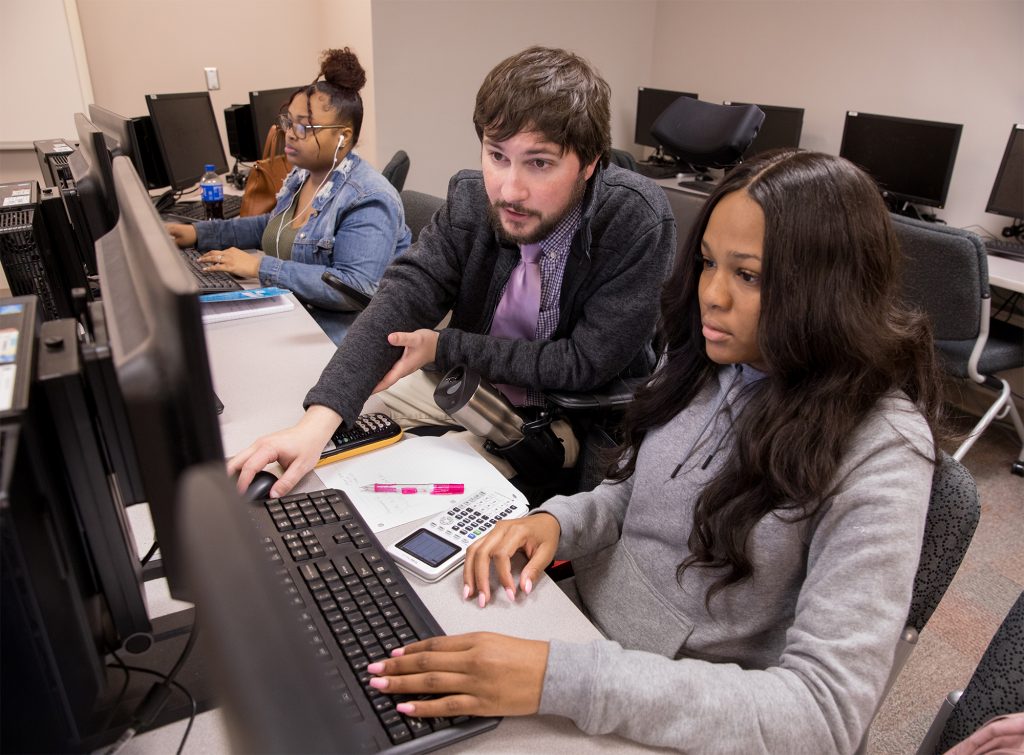
A Family of Devoted Dawgs
Melissa and her twin sister, Melinda, graduated from UGA. Melissa is a double Dawg, earning degrees in Art and German. Both of Matthew’s sisters are also UGA alumna—one worked for public television and the other is a radiologist. The family connections to UGA kept multiplying. “And both of their husbands are UGA grads,” says Matthew.
Each of his struggles caused his own sense of self to expand.
His big Ah Ha moment?
It was the connection between success and confidence. “I’ve spent a lot of my life very unconfident in my life,” Matthew says. “Grad school boosted my confidence and becoming a professor, also.”
When asked what might surprise people about him, Matthew says “I’m an introvert.”
He enjoys the early morning hours and quiet time. He also likes civility. It is one thing he emphatically “loves about the South,” right down to the Southern accent. As he grabs a fast-food lunch on campus, he gabs with the employees who know him by name. He knows theirs too, and inquires about their children, their families, and lives.
He may be an introvert, but he has mastered the art of social compensation.
At Last, a Fine Romance
The Houstons met in 2011 while working at Middle Georgia. “She was head of student life activities,” says Matthew. In 2011, he invited her on a date to see the movie X Man. They married in 2012.
When he was young, Matthew would fill notebooks, “knowing that the universe could be understood mathematically.” He admired the symbolism of math.
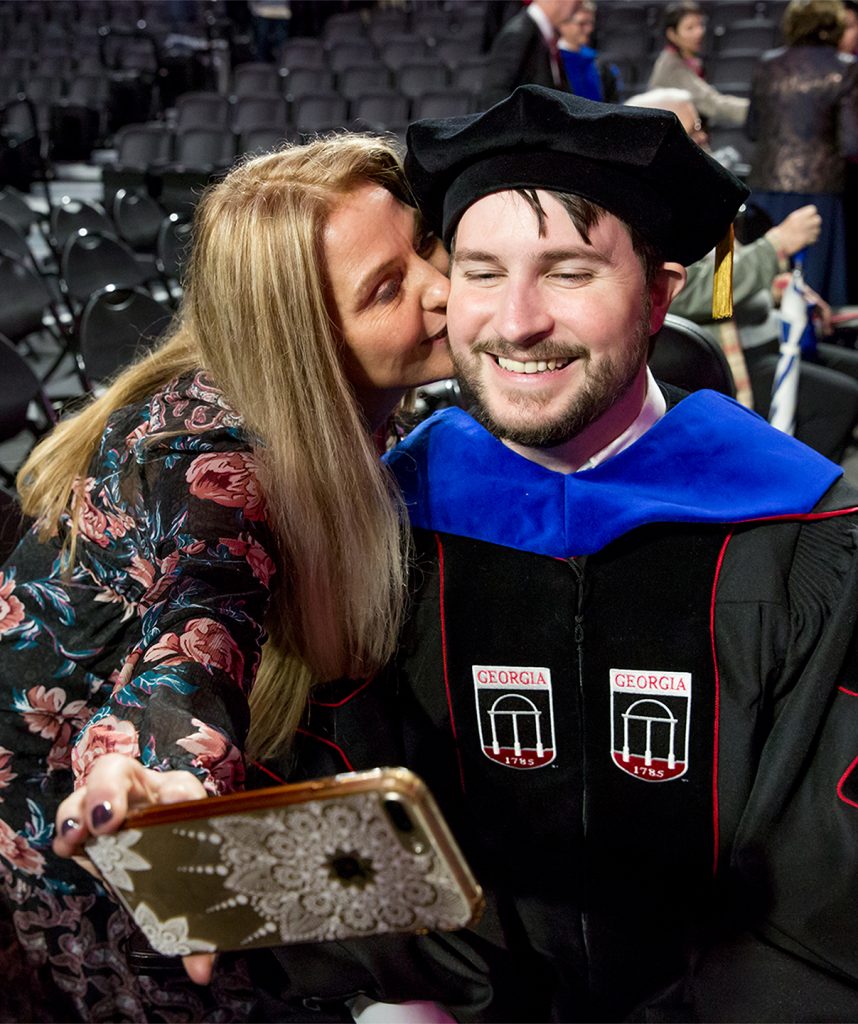
Matthew & Melissa Houston at 2018 Fall Commencement.
Melissa, an artist, visualizes concepts and the world via colors. She says Matthew does not. “He sees the sky and there are molecules; velocity and positions, operating on sets of objects. All these objects can be expressed by symbols; a connection between objects in the world and mathematic symbols.”
And there is his Melissa, whom he credits with sustaining him and his biggest dreams, while lending his world vivid color.
“She is my chief of chiefs. So, I gave her the name ‘Chief.’”
